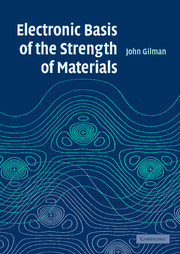Book contents
- Frontmatter
- Contents
- Preface
- Section I Introduction
- Section II Elements of solid mechanics
- Section III Elements of electron mechanics
- Section IV Elastic stiffness
- 9 Cohesion of atoms
- 10 Intramolecular cohesion
- 11 Intermolecular cohesion
- 12 Bulk modulus
- 13 Shear modulus
- 14 Entropic elasticity (polymers)
- 15 Universality and unification
- Section V Plastic strength
- Section VI Fracture resistance
- Index
- References
14 - Entropic elasticity (polymers)
Published online by Cambridge University Press: 14 August 2009
- Frontmatter
- Contents
- Preface
- Section I Introduction
- Section II Elements of solid mechanics
- Section III Elements of electron mechanics
- Section IV Elastic stiffness
- 9 Cohesion of atoms
- 10 Intramolecular cohesion
- 11 Intermolecular cohesion
- 12 Bulk modulus
- 13 Shear modulus
- 14 Entropic elasticity (polymers)
- 15 Universality and unification
- Section V Plastic strength
- Section VI Fracture resistance
- Index
- References
Summary
Introduction
Since both crystals and polymers are constructed of repetitive units (atoms or molecules), it is difficult to differentiate them. Roughly, crystals may be taken to be arrays of repetitive units in which repetition occurs in three dimensions. Polymers may be taken to be arrays that are repetitive in one dimension. However, there are two-dimensional as well as one-dimensional crystals. And there are two-dimensional, and in some cases, three-dimensional polymers. Thus, the distinction is not clean-cut.
Another classification approach is to say that crystals tend to be inorganic in character, whereas polymers tend to be organic. In a majority of cases this is true, but by no means all cases.
Covalent bonding within one-dimensional chains of atoms (or molecules) has already been discussed in Chapter 9. Most real polymers are two-dimensional, however, at least to the extent that the bonds form “zig-zag” patterns rather than straight lines. Thus, it is not possible to discuss the extension or contraction of polymer chains in terms of radially directed forces alone. Distortion of planar angles must be considered, and in most cases changes of rotational angles. This latter degree of freedom allows the contracted configuration to be that of a helical coil. Purely planar molecules are rare.
Intramolecular bonds are usually covalent, whereas intermolecular ones are usually due to London forces (in most cases Casimir forces can be neglected), but they can also be due to hydrogen exchange, or if the polymers contain polar groups they can be due to the interactions of pairs of permanent dipoles, or permanent/induced dipole pairs.
- Type
- Chapter
- Information
- Electronic Basis of the Strength of Materials , pp. 174 - 178Publisher: Cambridge University PressPrint publication year: 2003



